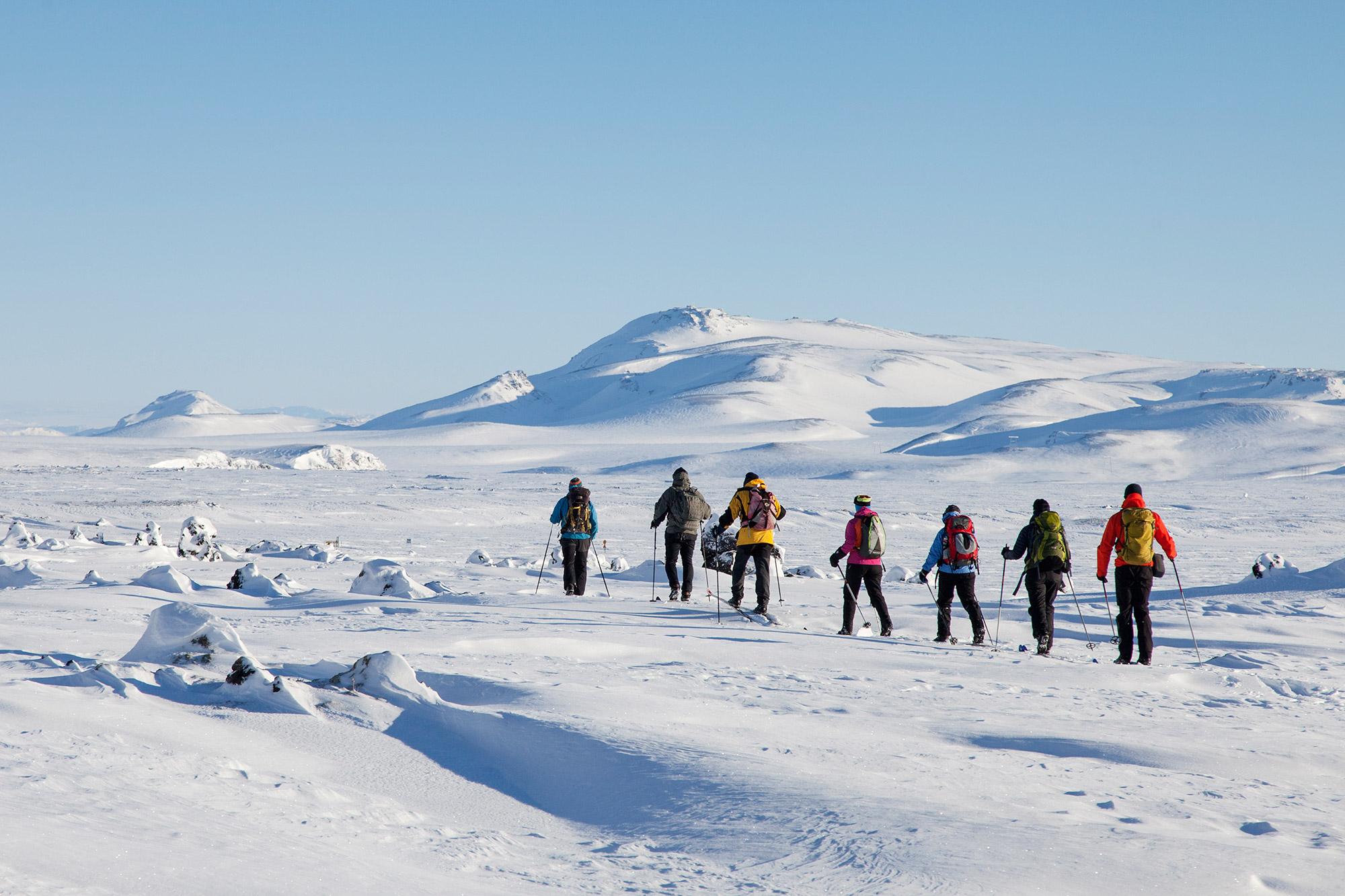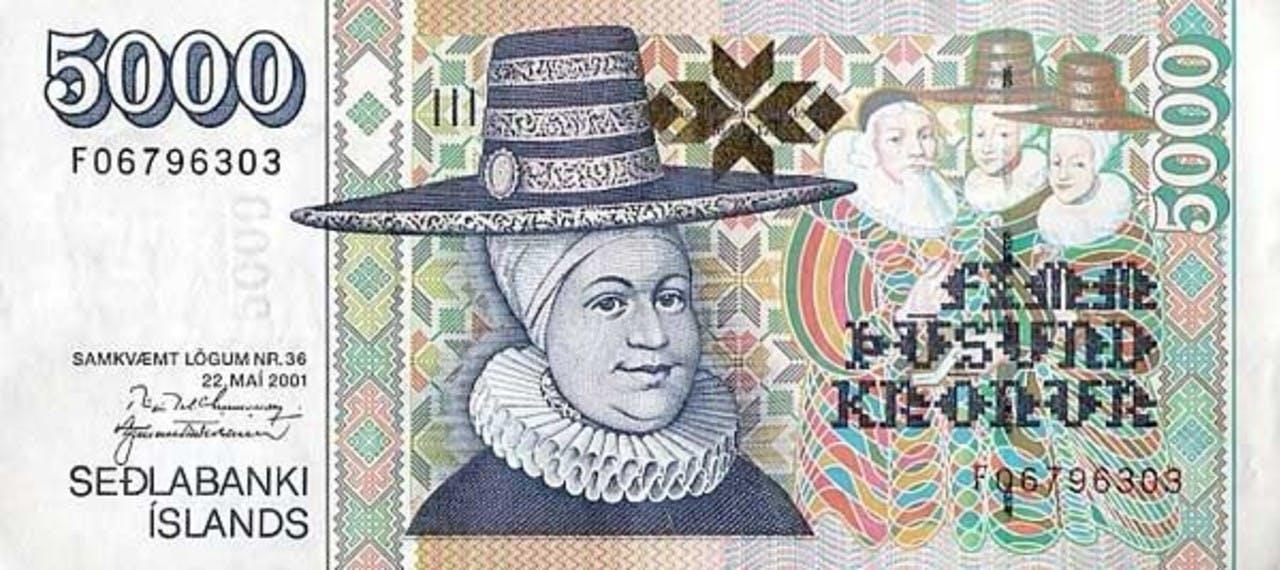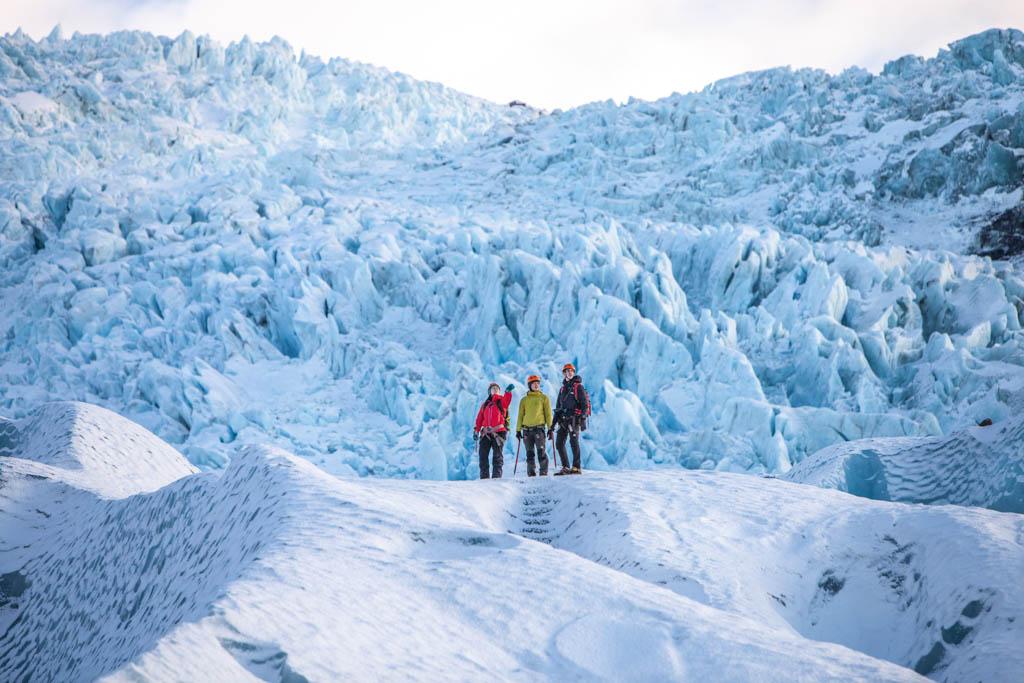What to Wear on a Glacier Hike in Iceland
| All, DISCOVER ICELAND, Travel Guide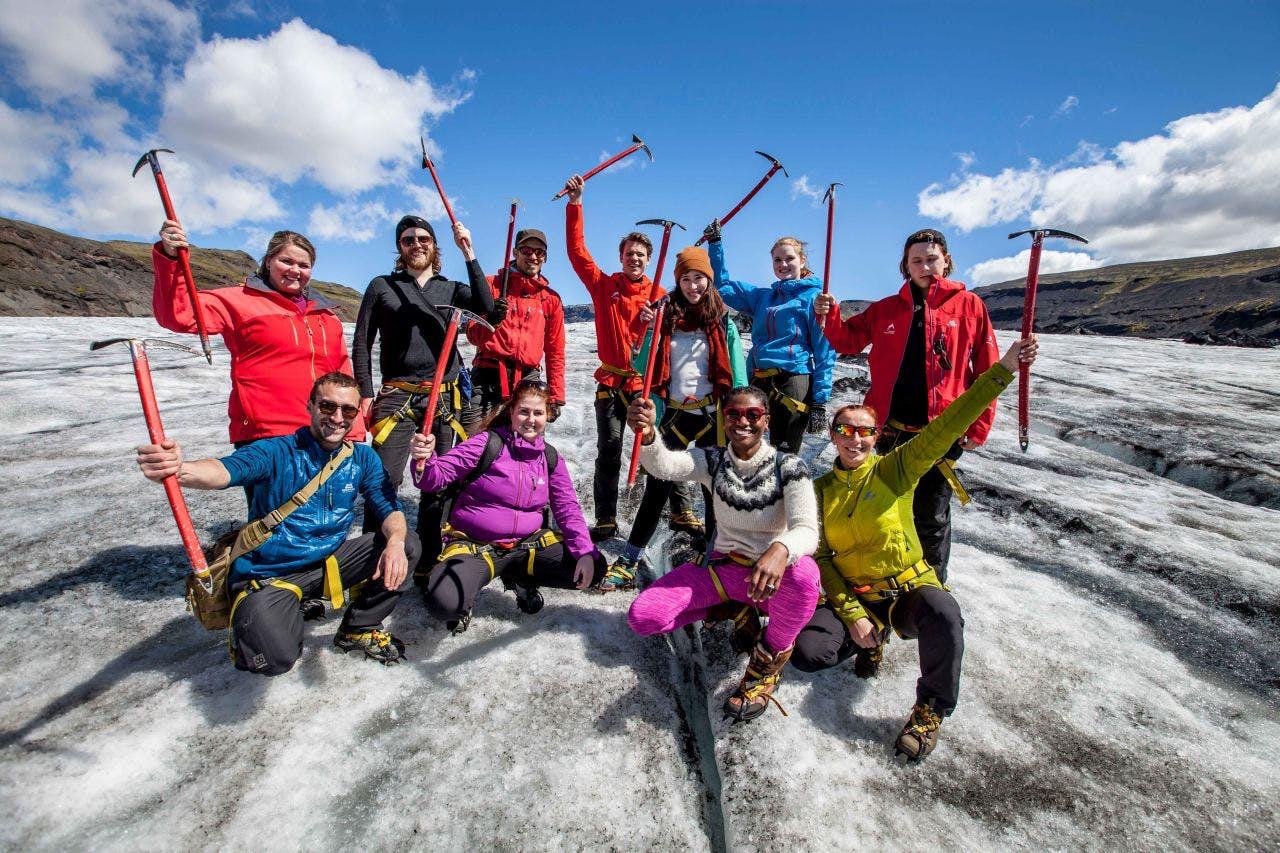
Group shot!
You've discovered Iceland's electrifying world of glaciers, and it's now top of your bucket list to hike on the ice. You've read about the crazy ice sculptures, the dazzling colours, and the excitement of walking close to deep-cut crevasses and churned-up ice.
Your next question is: What should I wear on a glacier walk in Iceland? Never fear; this blog will give you all the tips to prepare for glacier hiking. Once you've sorted your clothing and gear, you're ready to glacier hike Iceland with a diverse range of exciting trips on offer, thanks to Icelandic Mountain Tours.
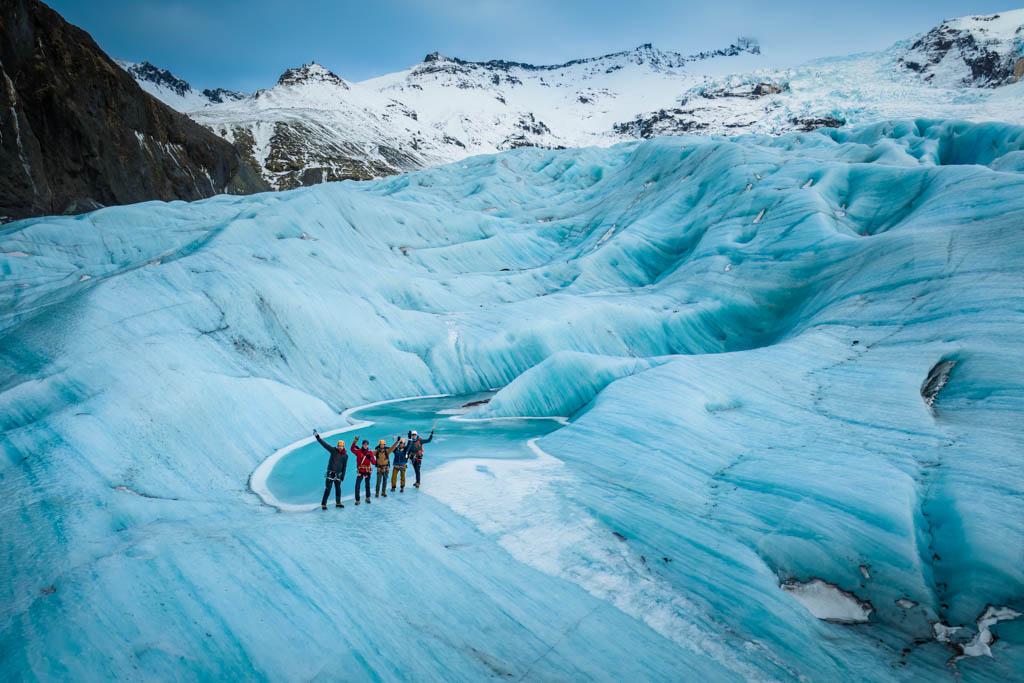
The beautiful Virkirsjökull glacier
At 66° north, Iceland is milder than you might expect because of the Gulf Stream, the strong currents that bring warm waters all the way across the Atlantic from the Gulf of Mexico. But when the warm air meets the cold Arctic air, it also brings unsettled weather.
It may be a cliché, but it’s true that sometimes in Iceland, you’ll experience four seasons in one day. Expect stormy weather or at least bursts of wind, rain, sleet, hail or snow along with sunshine when you’re out walking, and make sure you have the right clothing to deal with all of it.
If you’re glacier walking, always book a guide. On an Icelandic Mountain Guides glacier hike, you’ll be well looked after, and your guide will make your safety a number one priority. Your job is to ensure you have the right clothing and you’ve packed a rucksack with essentials for your walk-of-a-lifetime on the ice.
Dressing for outdoor physical activity, such as glacier hiking, is very different from sightseeing with short stops on a road trip. You’ll need sturdy boots, layers of clothing that are made of breathable fabrics (you can easily add or remove depending on how warm you feel), as well as waterproof and windproof outer layers. Hats, gloves and warm socks are important as heat is lost primarily through the extremities. A warm head will help keep the rest of the body warm.
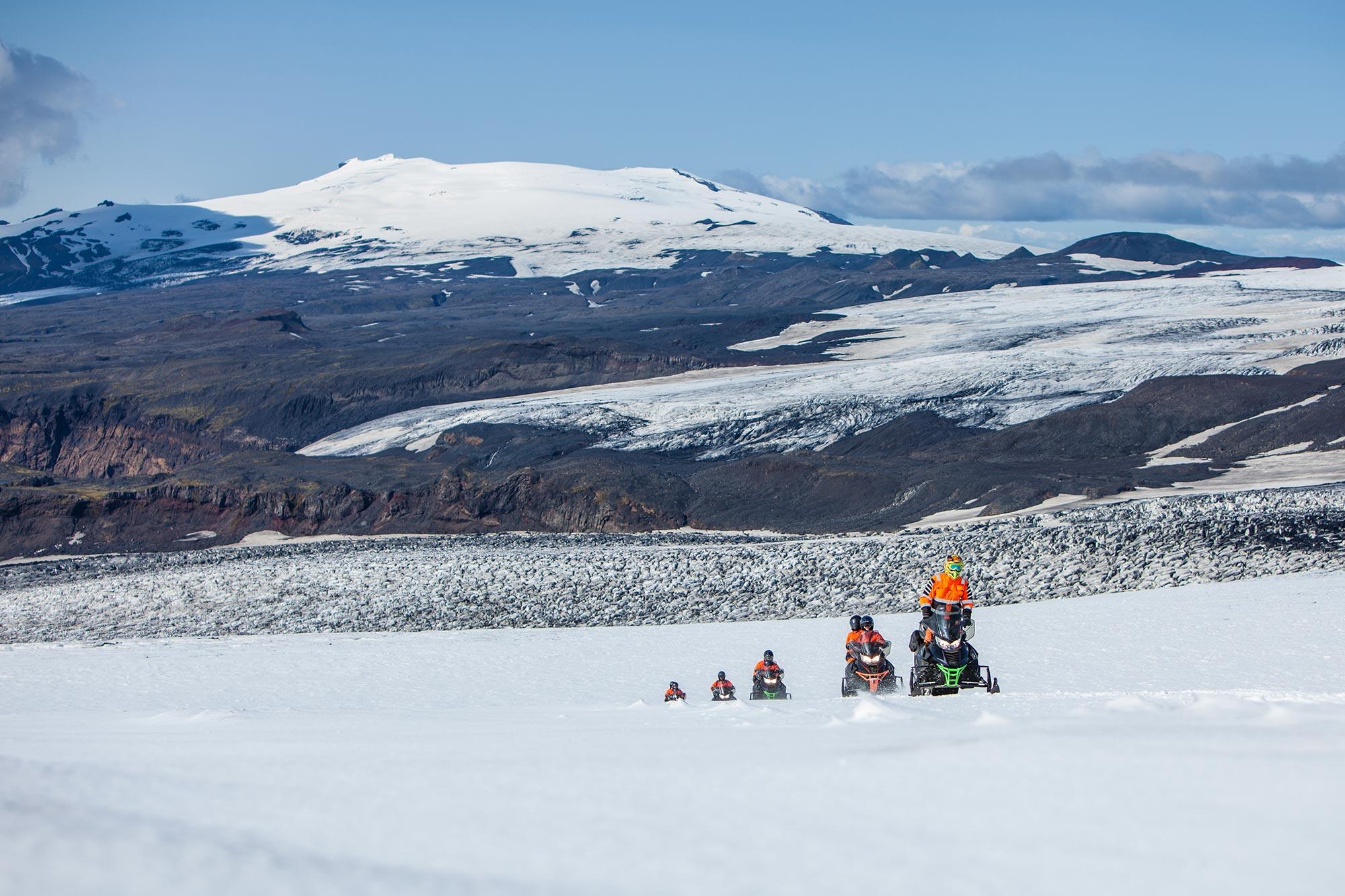
Your Ultimate Guide to Mýrdalsjökull
Iceland’s fourth largest glacier, book a tour and feast on Mýrdalsjökull’s expansive beauty. From the beguiling black beach below it to the enchanting colours and formations of its ice, Mýrdalsjökull is a place of extraordinary beauty. It’s also one big adventure playground. Take an ATV (all-terrain vehicle) to the atmospheric black beach plane crash site or let the adrenalin kick in on a snowmobile ride. Read more
Even though the weather is changeable, don’t let it put you off trekking in Iceland, and definitely don’t miss the chance to experience the thrill of walking directly on the ice. A glacier hike is often cited as the ultimate highlight of a trip to Iceland. Maybe you’ve always imagined glacier walks are for hardcore mountaineers. Not so.
Icelandic Mountain Guides offer sensational hikes on glaciers for beginners with typical levels of fitness. Moderately easy glacier tours such as the Skaftafell Glacier Walk or the Take a Walk on the Ice Side tour on Sólheimajökull will reward you with the hike of a lifetime.
We provide the equipment - ice axes and crampons, helmets and harnesses, and will show you how to use them. Our experienced guides will lead you safely through the glacier.
If you want something to satisfy the daredevil adventurer in you and are up for a challenge, try the full-day Glacial Wonderland hike. You’ll experience moulins, deep crevasses, water cauldrons and zany ice sculptures: six hours of pure glacier magic.

Five Popular Glacier Tours in Iceland that Will Blow Your Mind
So, you’re in and excited about booking your first glacier walk. But where to begin? Read up on five thrilling glacier tours that will exceed all your expectations. Check out trips with extraordinary ice formations, the dazzling spectrum of colours on the ice, glacier and ice cave combos or full-day tours that take in the south coast highlights along with an easy glacier walk. Read more
Whether you’re doing an easy, sweatless walk on the glacier or a full-day challenging hike, you will still need to be prepared for the cold and ice and the changeable weather conditions.
What is the weather like on the glacier?
Often the weather on the glacier is not too dissimilar to the surrounding terrain. As you’d expect, it will be a bit colder on a gigantic lump of ice! Melting ice and snow can also cause cold air to rise and condense, creating fog and low clouds that bring about precipitation, and when the cold, dense air masses of the katabatic winds stream downhill, it can be very blowy!
But don’t worry; experienced IMG guides closely monitor the microclimates of glaciers, plotting the best route on the day.

Your Ultimate Guide to Sólheimajökull
A living mass of ice containing all the shades of glassy white, ash grey and aqua-blue, you have to get up close and personal with Sólheimajökull to appreciate its beauty. How about combining a walk on the glacier with ice climbing or kayaking on the glacier lake?
Read more
The science of dressing in layers for cold outdoor activities
As we said, the weather can change quickly in Iceland. It can be sunny and relatively warm one minute, raining, hailing or snowing the next. In exposed places, the wind can cut right through you, while in sheltered places it can feel much warmer.
With this in mind, it makes sense to wear several layers you can remove and add back on again, depending on how warm you feel. Burning up a lot of energy on difficult terrain or fighting gravity on an ascent, you’ll find yourself removing layers.
In an exposed spot, pausing for a break, or walking through cold ice and snow, you’ll want to put them back on again. The beauty of layering is each layer traps the air, providing insulation. Here’s how it works:
Base layer
This is your underwear layer. What you need may not be sexy, but to tell you the truth, it won’t matter if snow or icy-cold rain is coming down on a glacier: you’ll be glad of it. Next to your skin, this layer should be soft, warm and comfortable.
Above all, it should wick away perspiration. You want your base layer to be breathable and close-fitting (thermal, fine wool - merino is top-grade - or synthetic materials are best). Long leggings (long johns) and long-sleeved vests will keep you warm and comfortable in the coldest weather conditions.
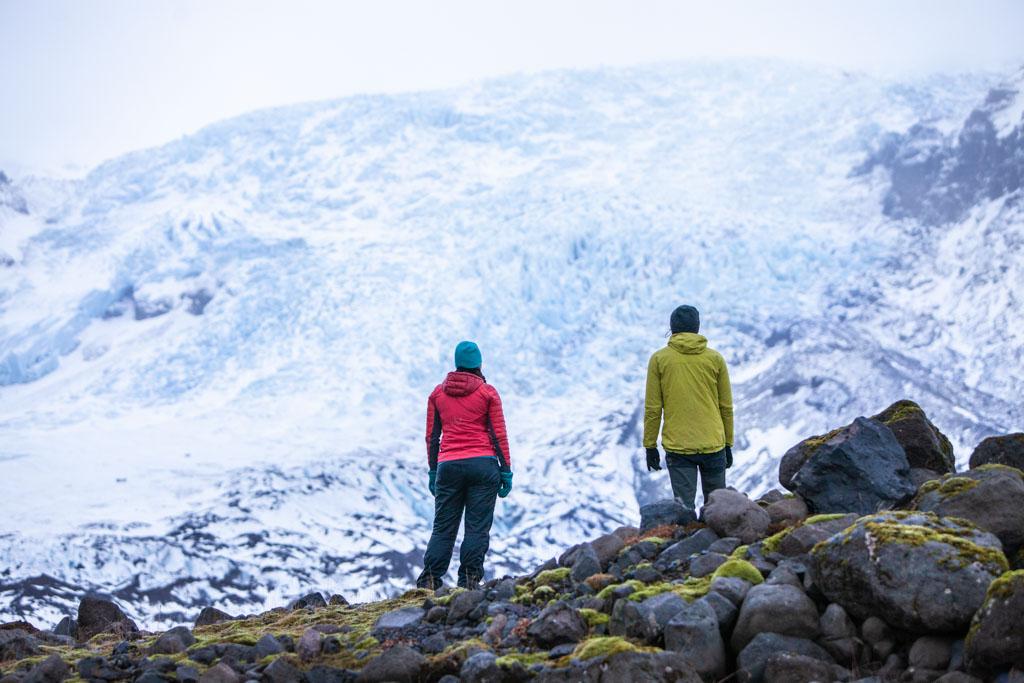
How to dress for a glacier hike
Insulation
The insulation layer is basically the normal outdoor clothing you wear when out hiking or, in this case, glacier walking. Once again, light, breathable fabrics are your friend, keeping you warm and dry.
Synthetic tops, woollen sweaters and fleeces are all good choices. Lightweight layers rather than bulky, heavy fabrics are what you’re after. Warm, loose-fitting, flexible and water-resistant hiking trousers are best. For the coldest conditions, consider ski trousers or shell trousers with a fleecy lining.
Shell Layer
The outer layers - your waterproofs - are crucial, even if it’s warm and sunny when you set out. They should protect you from wind, rain and snow. Think windproof, waterproof and breathable raincoats and overtrousers.
Footwear
Proper walking boots are an essential item of clothing for your glacier hike. Trainers will not do the job. The soles of your boots should be thick and have a good grip. They should also be hard-wearing, waterproof and, above all, give you good ankle support.
Headwear and accessories
Buffs are great for protecting the neck (and ears). Waterproof gloves are vital along with a warm hat that’s not too bulky so that it fits under a helmet. Even in winter, you’ll need sunglasses (the light-reflecting snow can be blinding). Take hand cream and lip balm because the cold, dry conditions, alongside any bright sun, dry out the skin. Lastly, you’ll need a knapsack for your water bottle, flask and snacks. Think high-energy snacks: nuts and dried fruits, energy bars and chocolate.
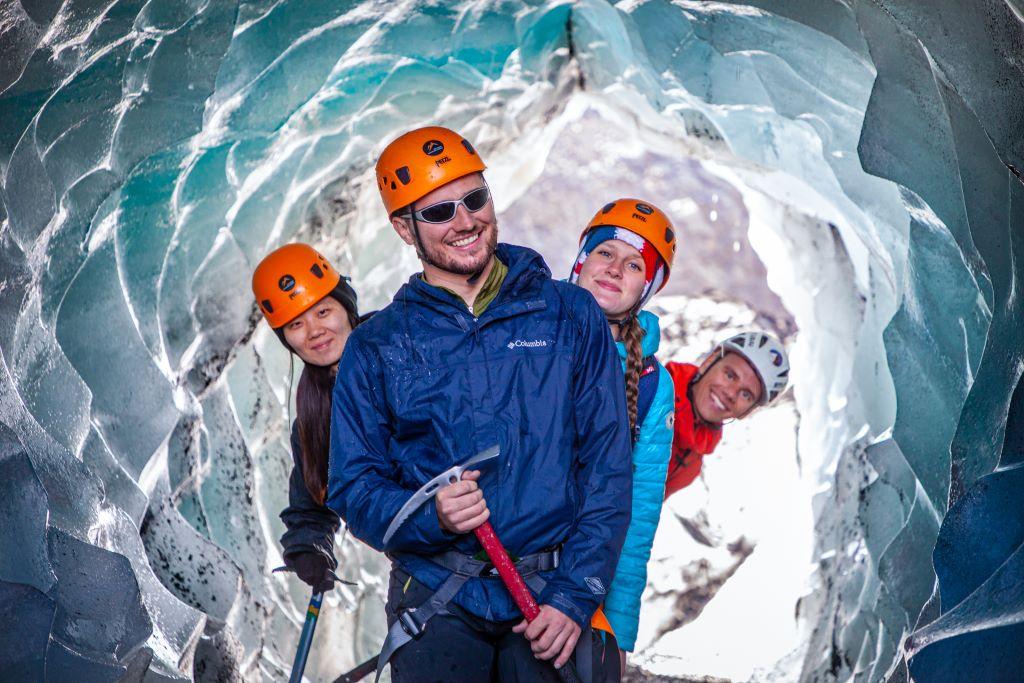
Happy glacier hikers

The Ultimate Guide to Skaftafell
Explore some of Iceland’s most captivating landscapes in the nature reserve of Skaftafell. Surrounded by the glacier worlds of Vatnajökull, Svínafellsjökull, Skaftafellsjökull, and Skeiðarárjökull and overlooked by the tallest mountain in Iceland, the ice-capped Hvannadalshnúkur, this is an intoxicating landscape to experience. There’s also the sublime waterfall of Svartifoss with its striking basalt ‘organ pipes’.
At a glance - your questions answered
How cold is a glacier hike in Iceland?
In winter, the temperature can dip below freezing, but in summer, the temperature can climb as high as 12℃. Expect anything in between throughout the year.
What should I pack for a day hike on the glacier?
- A backpack large enough to hold any clothing you shed along the way, plus drinks and snacks
- Lip Balm, sunscreen and sunglasses - the sunshine can do a lot of damage, even in winter
Is it hard to walk on a glacier?
Your guide will set the pace in accordance with the slowest in the group. Don’t expect a quick march - they will frequently stop to explain the wonders of the glacier. If you can walk uphill and downhill and negotiate uneven ground, glacier walking isn’t difficult.
Your expert will show you how to walk with crampons and how to use an ice axe. Glaciers are extremely dangerous places, however, so never think of going it alone.
What shoes should you wear on a glacier walk?
Always wear proper hiking boots. They should be waterproof and have good ankle support alongside thick soles with good grip.
Is a glacier hike in Iceland worth it?
Yes, yes and yes! You won't experience a hike like it: the brilliant snow; the crazy ice formations; the dazzling shades of whites, greys and blues; the sheer glacier walls, deep crevasses and surrounding mountain peaks.
What should you not wear during a glacier walk?
Never wear jeans. When they become wet, they are weighty, stiff, uncomfortable and cold. Even when dry, they lack flexibility. Don’t wear trainers: they won’t give you the ankle support you’ll need on the uneven ground of a glacier.
Don’t have hiking boots? No worries: you can rent them from Icelandic Mountain Guides.
What do you wear to the ice caves in Iceland?
If crampons, headlights, hardhats, ice axes and safety harnesses are required, your guide will provide them. It’s going to be cold down there - expect sub-zero degrees. As for above the ice, dress in layers - and make sure you have enough of them to stay warm. In short, you should have:
- Ankle-supporting walking boots
- Layers of lightweight (but warm) breathable clothes
- Waterproof outer layers - water will drip inside the ice cave
- A hat fine enough to fit under a helmet
- Gloves and warm socks
So, what are you waiting for? Lace-up your boots, wrap up warmly and get out on the ice. For the very best experience, hike a glacier in Iceland with Icelandic Mountain Guides.
Keep me informed about the Icelandic Mountain Guides Blog
Outdoor adventure in Iceland is our specialty. Subscribe to our free monthly newsletter to learn when to go, what to do and where to have the best adventures in Iceland.
Related Blog Posts
Related Tours
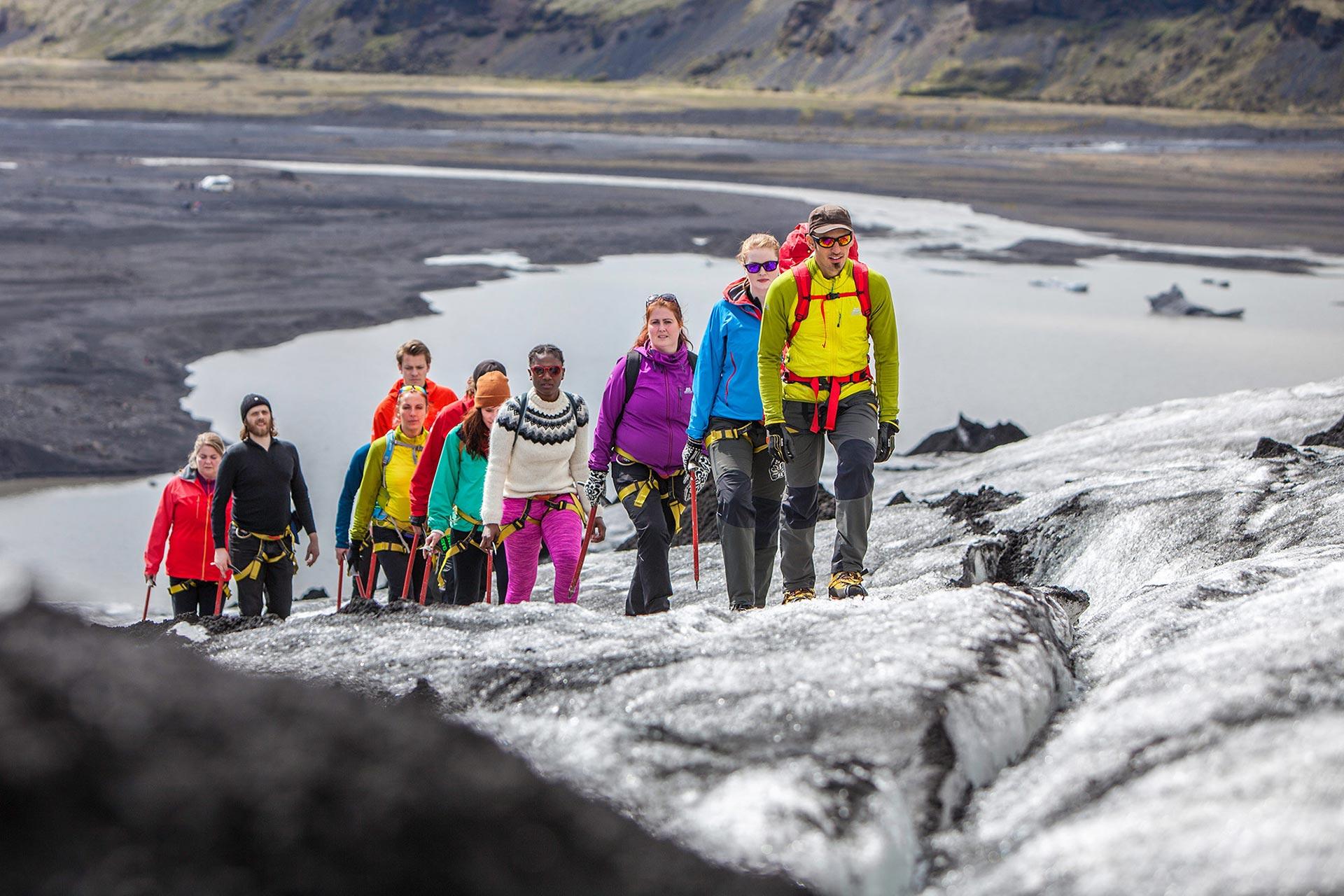
Take a Walk on the Ice Side
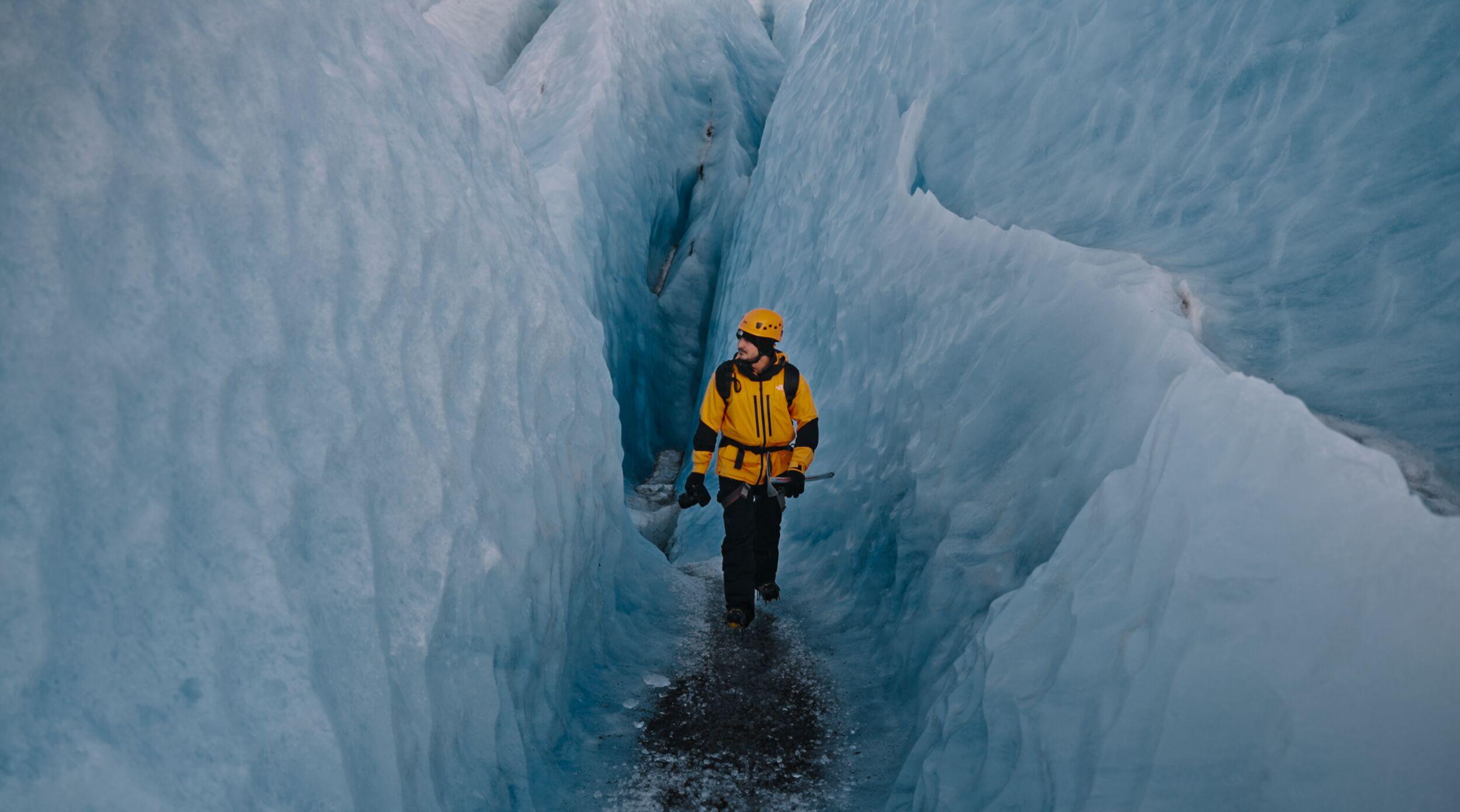
Blue Ice Experience - 3.5-hour Skaftafell Glacier Hike

Skaftafell Ice Cave Tour & Glacier Hike
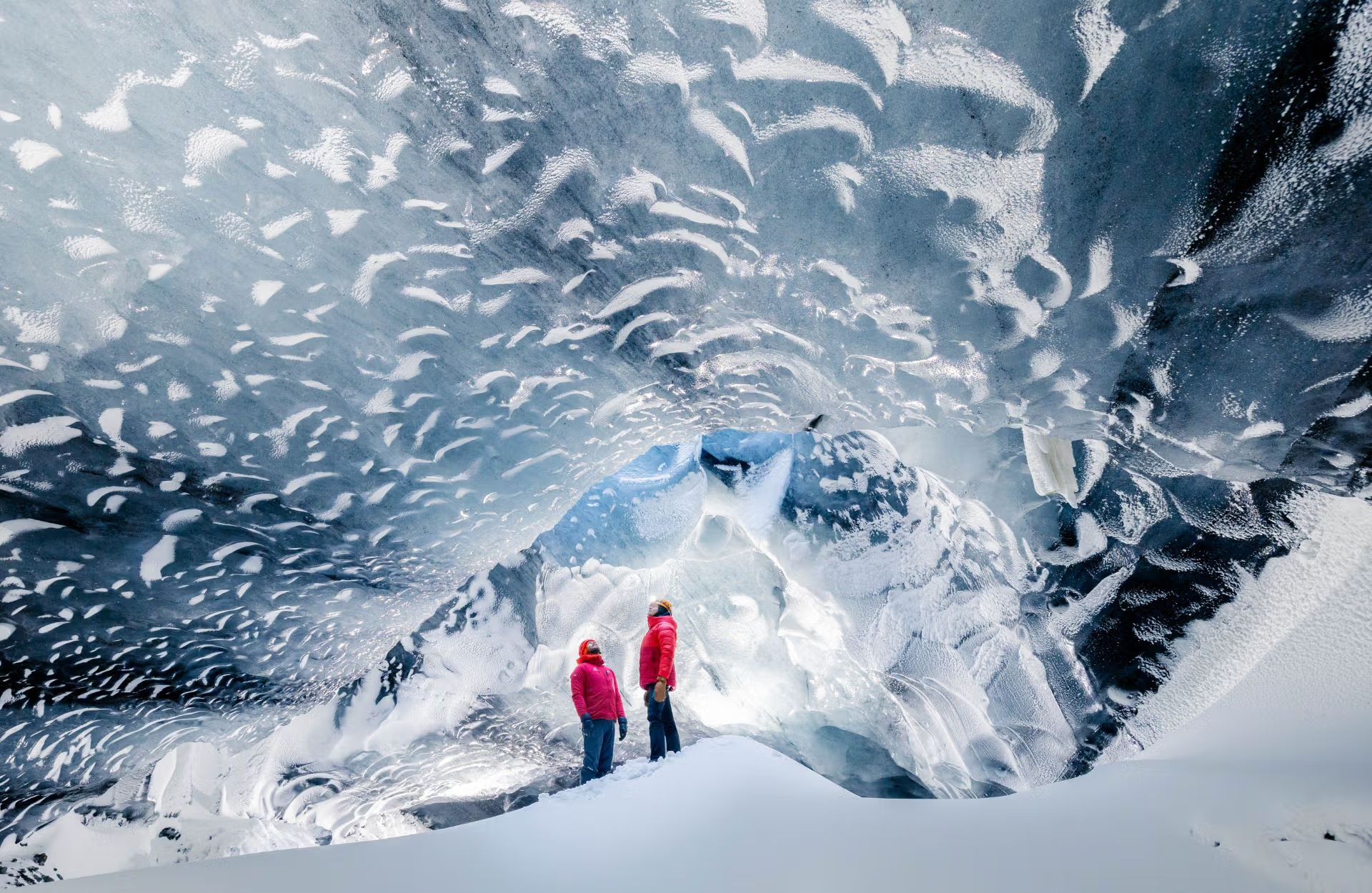
Askur Ice Cave Adventure

Glacier Exploration - 4-hour Sólheimajökull Glacier Hike

